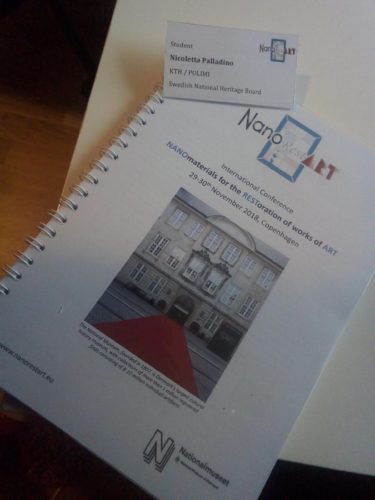Hi everyone! I am Nicoletta, a master thesis student at Riksantikvarieämbetet from POLIMI/KTH. Here it is a short report of the final conference of the European project NANORESTART held in Copenaghen on the 29-30th of November 2018.
I attended the conference with my supervisor Marei, and it was a great opportunity to get to know results and future of nanotechnology for cultural heritage. Insights from researchers and conservators were given, as well as business perspectives. Inspiring proposals for several topics in the field of conservation and restoration of cultural heritage were the starting point for interesting talks in an exciting international environment.

The first session dealt with new tools for cleaning, mainly the new gels (PVA and PVP-based) and complex fluids developed by the research group of prof. Baglioni (CSGI, University of Florence).
The topic of the second session was surface consolidation systems for conservation of fibrous materials mostly developed at Chalmers. Properties and applications of different kinds of nano silica and nano cellulose were presented, with examples of different approaches and substrate materials. A particularly interesting session as it was related to my work at Riksantikvarieämbetet, where I have been testing different combinations of those materials for the consolidation of iron-tannate dyed textiles (cotton
substrate).
Active and passive coatings for surface protection were the topics of the third (plastic surfaces) and fourth (metal surfaces) session. Durability, reliability and sustainability of the coatings were the main points taken into account.
The second day started with the presentation of new sensing and diagnostic systems for detection of degradation products. The section dedicated to new highly-sensitive and less invasive SERS techniques was very interesting and looked promising for many applications. Then, the results of the environmental impact assessment of the products within NANORESTART were shown, underlying the attention given to sustainability already from the development process.
Finally, a business perspective on use, application and exploitation of the products was given, followed by a panel discussion where representants of research and business discussed together the main issues for the real success of the products, from the limited market and budget available to the real breakthrough they would represent in the field of conservation science. Hopefully it will be the starting point to build up other constructive international collaborations.
Looking forward to come back to Gotland in January, I wish you a nice day and merry Christmas!
Nicoletta Palladino
NANORESTART